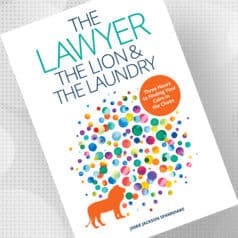Why Is It So Hard to Figure Out What We Want?
Table of contents
Whether trying to decide what job to pursue or which couch to buy, it can be really hard to figure out what we want. Maybe that’s because we are listening to the wrong guidance. It could be unhelpful guidance from others. But, quite often, it is unhelpful guidance from ourselves.
Sometimes figuring out what we want is not about going through a logical list of factors and weighing pros and cons. Rather, it is a process of getting in touch with and listening to our inner desires. This can be hard for anyone but is particularly difficult for lawyers. We are a logical bunch. That’s what we are paid to do: assess risks and benefits, figure out the options logically, and resolve.
But that may not be the best way to make big and small life decisions.
In fact, it may not be the best way to make decisions for our clients either. When I provided legal counsel to businesses, I would always lay out the risks and benefits of any proposed action, as well as the challenges and how to avoid or mitigate them. Ultimately, though, I would ask, “But what do you want to do?”
When we start with what we want, we can figure out how to get it.
To Figure Out What You Want, You Need to Follow a Different Approach
This is especially true if you’ve been trying to determine what it is that you want for some time, without success. As Albert Einstein is attributed with saying: “Insanity is doing the same thing over and over and expecting different results.”
Let’s not be insane. Let’s take a new approach with these five ways to figure out what you want.
1. Start by Getting Clear on What You Don’t Want
When figuring out what they want and what direction they want to go in their careers and life, many people find it easier to know what they don’t want. Part of the reason is that we can have lots of “don’t wants” but feel we need to narrow what we do want to just one perfect thing. You don’t need two couches, only one. You don’t need two full-time jobs, only one. You get the idea.
So, if you are having trouble figuring out what you do want, start with what you don’t want. Grab a journal or piece of paper and complain about everything that you don’t like in your life. Don’t feel guilty about it. Don’t focus on all you have to be grateful for, just for this exercise. Relish in venting and complaining to really understand what you don’t want.
This can be cathartic for some people but can leave others feeling really negative. Regardless of how you feel after venting, take time to journal or think about all that you are grateful to have and be. This gratitude list is the beginning of your foray into what you want.
2. Let Go of the “Shoulds” That Don’t Align With Your Values
There are many things in life that we are told we “should” do. Often, those “shoulds” are other people’s ideas about what we need to do. If there are many things you do only because someone else told you they are important or worthy of your time, it may be time to assess whether those things align with your values.
When you are clear on your values, you can more easily make decisions about what works for you and what you want.
But what if you aren’t sure what your values are? You can create your own Personal Values Statement by following the exercise in my book, “The Lawyer, The Lion, & The Laundry: Three Hours to Finding Your Calm in the Chaos.” (You can get a free excerpt that includes the Personal Values Statement guidance and exercise, here.)
3. Rest Your Brain to Find Creative Solutions
When the brain is resting, it isn’t idle, purposeless or unproductive. To the contrary, downtime improves the mental processes in the Default Mode Network (DMN) of our brains. And that allows us to be open-minded and find creative solutions.
The DMN is the part of the brain that activates when we are not focused on any particular task, like when we are daydreaming or meditating. Giving your mind time to utilize the DMN is crucial to creatively solve problems. This is the phenomenon you experience when you have a sudden epiphany while in the shower or waiting in line.
This happens because a wandering mind removes the constraints of time so that we can learn from the past and plan for the future. The epiphany seems to come “out of nowhere,” but in fact, it is the result of unconscious mental activity enabled by downtime.
As my dad says, “The time we enjoy wasting is not wasted time.”
In our very busy lives, downtime can be hard to come by. It may be that the only way you can get downtime is to schedule it. So, block out 15 minutes or two days — whatever you can manage — to allow your brain to rest. Meditate. Do yoga. Take a nap. Go for a walk in the woods. Whatever allows your busy, logical brain to rest.
4. Recognize That Our Psychology Makes It Hard to Know What We Want
Our psychological processes protect our self-esteem, but they can also keep us from digging deeper and exploring our underlying truths. This can show up in several ways when we are trying to figure out what we want.
For example, we tend to like things we think are possible more than things we think we cannot achieve or have. If you really want to be a state judge but you don’t believe you could possibly achieve that goal, then you may decide that you don’t actually want to be a state judge.
On the flip side, sometimes we want things simply because we think we cannot have them. When we pursue things that are forbidden, we often lose touch with our true desires and become sidetracked by the pursuit.
Recognizing these psychological tendencies allows us to understand why we are making decisions that aren’t helping us live the lives we want.
5. Learn to Enjoy the Discomfort of Uncertainty
We like to know what’s going to happen in life. That’s one reason our brains like the status quo more than change. Transformation is uncomfortable, so we may decide we “like the devil we know” more than the devil we don’t know — even when that “devil” might turn out to be an angel bearing newfound happiness. We can err on the side of making any decision just to relieve the uncertainty.
Learn to enjoy the experience of exploring opportunities along the path to figuring out what you want. If you can relax into the process, it can be exciting. Experiment with different actions and enjoy learning and growing, knowing you will get to the right decision. Remember that self-improvement guru Dale Carnegie said inaction breeds doubt and fear, whereas action creates confidence and courage.
Give Yourself Time to Go Through the Process
You can use these steps to know who you are and what you truly want without your logical mind muddying the vision of the outcomes you desire. It is a process and it may take you a bit longer than is comfortable to come to a decision. But in the end, you will know you’ve made the right decision. You will waste less time following the wrong path and more time doing and having what you truly want. It takes time, but it’s worth it.
You are worth the effort.
Illustration ©iStockPhoto.com
Have You Read Jamie Spannhake’s Bestselling Book?
 Find Your Calm in the Chaos
Find Your Calm in the Chaos
In “The Lawyer, the Lion, and the Laundry: Three Hours to Finding Your Calm in the Chaos,” lawyer and certified health coach Jamie Spannhake helps you learn how to CHOOSE, ACT and THINK in ways that will clarify your desires and set priorities so you can reclaim your time and enjoy your life.
Available in the Attorney at Work bookstore, here.

















